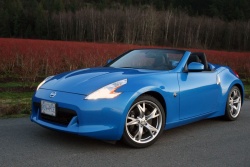 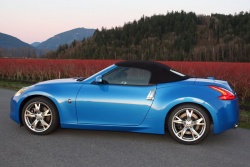 2010 Nissan 370Z Roadster. Click image to enlarge |
|
Related articles on Autos
Manufacturer’s web site
|
Review and photos by Russell Purcell
Find this vehicle in Autos’s Classified Ads
Photo Gallery:
2010 Nissan 370Z Roadster
When the 370Z first hit the streets last year it was obvious that the decision makers at Nissan were careful not to stray too far away from the design and aspirations of the outgoing 350Z, as that model had garnered a huge following and loyal customer base due to its unique styling, sporty performance, and rear-wheel drive layout. As a result, the new car is immediately recognizable as a Nissan as its overall appearance still resembles that of its forbearer.
The 370Z was penned by Canadian designer Randy Rodriguez, who credits his styling to ideas derived from the physical appearance of sharks. The influence is evident in the resulting shape of features like the car’s head and taillights, which both reflect the curved angles of a shark’s tail and dorsal fin.
The bodywork on the doors gently sweeps upwards meeting the wide rear fenders, integrated roll hoops and high rear deck. The car looks best with the top retracted, as great care was taken to conceal its structure beneath the rear deck panel giving the car a very clean and uncluttered look. In my opinion, the 370’s design represents a near-perfect blend of refinement and aggression, and is the result of the careful evolution of the previous model’s wedge shape and teardrop tail treatment. The side profile reveals that the car is a little shorter than the 350Z (4,314 mm vs. 4,246 mm), and interestingly, the wheelbase is also compressed by 100 mm. The 370Z sits almost a centimetre lower than the 350Z, and benefits from a wider track front and rear, as well as a slightly wider body. Add to this more power and a weight reduction of over 35 kilograms and you get a car that reacts quickly to driver inputs and feels planted to the road surface when driven hard.
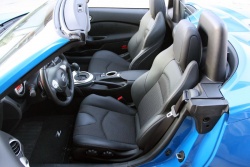 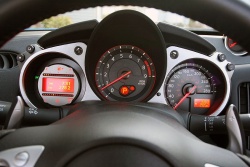 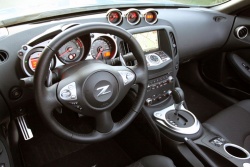 2010 Nissan 370Z Roadster. Click image to enlarge |
The interior on my test vehicle felt almost spacious as there is a little more room to stretch out in the cabin due to the increased width of the “Double Cockpit” design. The twin sport buckets seem infinitely adjustable via a pair of scroll knobs on the outboard side (which manually regulate cushion height), while power switches for recline and fore-and-aft positioning reside on the console-side of the seat edge. These highly supportive seats did an excellent job of holding me in place during aggressive manoeuvres, yet proved comfortable enough for long-distance touring as well. Both seats are equipped with heating and ventilation units as standard equipment to cool you down after a hot lap at a track day, or alternately, warm you up during an evening drive.
Instrumentation is grouped together in a compact three-gauge cluster arrangement. The large tachometer is centre stage, and sports a hood extension to shade its face from sunshine when the top is down. It also features a small digital readout to let the driver know what gear is in use and a lofty 7,500 rpm redline. A traditional white on black colour scheme offers excellent visibility, but at night, a bold orange glow is used to bring the gauges to life when you hit the pushbutton starter. All controls are driver oriented and within easy reach.
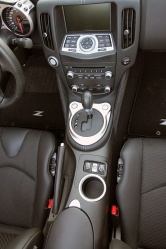 2010 Nissan 370Z Roadster. Click image to enlarge |
The three-spoke steering wheel features a host of secondary controls, but it is the column-mounted paddle shifters that beg for your attention. Some people may still prefer to use the automatic’s traditional console lever to shift via a simple side-gate, but the lightweight paddles used on this car are about the fastest units on the market and have been engineered to entertain.
The centre stack on my test car featured a seven-inch-wide multi-purpose screen (part of the optional Navigation Package) matched with Nissan’s excellent control panel. The simple switchgear for both the Bose audio and HVAC systems is well placed, intuitive to use, and exceptionally well-integrated with the overall cockpit design. A trio of secondary gauges sits atop the dash, angled in a manner to allow the driver to steal a glance without straying too far away from the task at hand.







 Follow Autos on Twitter
Follow Autos on Twitter



